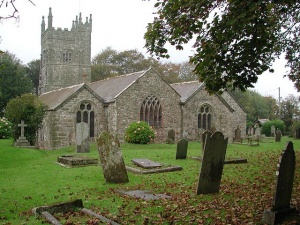Sant Eginer
Un article de GrandTerrier.
1 Fiche signalétique
|
2 Almanach
| |||||||||||||||||||||
3 Sources
|
4 Iconographie | |||||||||||||||||||||
5 Monographies
Site Bretagne.net :
Eginer
prénom masculin, fête le 14 décembre
Déclinaisons du prénom breton : Eginera - Gwinier
Origine du prénom
Fils d'un roi d'Irlande, il vint évangéliser la Bretagne au Ve siècle.
On retrouve sa place du côté de Vannes, où dans la cathédrale, une chapelle lui est dédiée. Patron de Pluvigner (56), il a laissé son nom à Loc-Eguiner (29).
prénoms celtiques et bretons d'Albert Deshayes :
Gwinier
Sa Vie, calquée sur celle du saint irlandais Fingar, en fait le fils de Clito, un roi d'Irlande. Converti par Patrig, son père le contrait à l'exil. Suivi de plusieurs compagnons, il se réfugie en Armorique et aborde en un lieu non mentionné, où le seigneur local leur fait don d'autant de terres qu'un homme à cheval pourra en parcourir en un jour. Alors qu'il chasse le cerf, il décide de se consacrer à Dieu et se fait ermite, abandonnant ses compagnons. Bientôt à nouveau réunis, ils fondent un monastère. De retour en Irlande, devenue chrétienne, il refuse de succéder à son père, puis se rend en Cornwall avec un groupe de chétiens. Mais le roi Théodoric, redoutant qu'ils convertissent son peuple, les attaque par surprise et les fait tous massacrer.
Ce saint au nom brittonique (Gwinear en cornique), attesté dans le cartulaire de Llandaf, ami de Meriadeg, pourrait être, comme lui, originaire du pays de Galles. Il est représenté sous les traits d'un évêque dans l'église paroissiale de Pluvigner (56).
Forum orthodoxe :
Saint FINGAR (GWINNEAR, GUIGNIER), Irlandais de nation, ermite en Bretagne, martyr à Hayle près de Penzance en Cornouailles avec sa soeur sainte FIALA, moniale, et une autre moniale irlandaise, sainte HIA (JIA, JIES), éponyme de Sainte-Jies en Bretagne (vers 455).
Site Prier ensemble :
Saint Fingar
Fête le 14 Décembre
Connu aussi sous le nom de saint Guigner, martyr en Bretagne, au cinquième siècle, particulièrement honoré à Vannes.
iriscatholicchurch@yahoogroups.com :
St. Fingar (Gwinnear, Guigner), Phiala, and Companions, Martyrs
5th century; Fingar may have a second feast on March 23, or this could be a different saint. Irish legend recalls that Saint Fingar, son of the king of Connaught, was converted by Saint Patrick; however, he may have been a Welshman or simply a missionary in Wales. His feast is commemorated at Vannes in Brittany, where he spent some time as a pilgrim. His sister Phiala also left their native Ireland and crossed over to Cornwall with Fingar, but they were put to death at Hayle near Penzance by a pagan chief. Theirattendants shared their crown. Saint Fingar is the patron of Gwinear in Cornwall. (Benedictines, D'Arcy, Montague, Moran).
The Church at Gwinear, Cornwall
The site of the original Celtic church is claimed to be at Trungle and would have been a simple wooden oratory in a round enclosure. That the present church site has Celtic foundation is strongly suggested by the finding in 1954 of the top of a granite churchyard cross built into the wall of the vicarage. the Christ-figure is depicted wearing a tunic showing it to be early Byzantine design, perhaps 9th century. It is now kept in the church window by the font. The ancient cross which once stood at Roseworthy is considered to be perhaps the most beautiful cross in Cornwall, and was removed in the 18th century for safety to Lanherne Nunnery, Mawgan in Pydar. The large cross which is now in the churchyard , near the main porch on the north, was removed in 1858 from a point about half-a-mile east of the church.
http://homepages.tesco.net/~k.wasley/GwinearCH..htm
